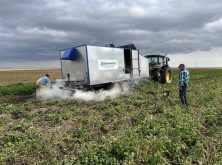It’s no secret that herbicide-resistant weeds are making life increasingly difficult for many crop growers in Western Canada, but the situation is far from hopeless, says an agricultural expert.
Canada currently ranks third in the world for herbicide-resistant weeds, trailing only the United States and Australia in that category. Studies have shown there are currently 77 resistant weeds in this country, with kochia leading the way as the largest threat to crop production, especially in Western Canada.
Read Also

Cancer agency reclassifies another herbicide ‘probably carcinogenic’
The WHO’s cancer research agency has now put atrazine, a herbicide well known to corn growers, in the same potential-hazard category where the agency put glyphosate.
Nolan Kowalchuk, technical sales manager for FMC Canada, says as problematic as the situation may be, growers do have some options when it comes to mitigating the pressures of herbicide resistance.
One of the most effective tools in that fight, he says, is herbicide layering. Herbicide layering is the use of multiple active ingredients and herbicide groups at different application timings. In a pre-seed burn-off timing, it incorporates soil-applied products to control target weeds while they are emerging along with utilizing tank-mix strategies with glyphosate to control already emerged weeds.
Growers then have the potential to use other available modes of action as in-crop, pre- or post-harvest applications. The more effective modes of action that can be introduced at different application timings help to ensure control of a resistant weed so it does not mature and return seed to the seed soil bank for future years.
The importance of herbicide layering, Kowalchuk explains, is it minimizes the selection pressure for resistance that can occur with the application of a single mode of action product or the repeated use of the same herbicide or tank mix continually.
“The thing with weed resistance is there’s no silver bullet answer that works for all,” he says. “It all comes down to proactive planning and developing a practical, working strategy for helping prevent herbicide resistance from developing or managing it as if it has already developed. It’s all about developing an overall weed resistance management strategy.”
Where to begin
In order to develop an effective herbicide layering strategy, Kowalchuk says producers must first ask themselves some questions. For example, what weeds are growers targeting? When do those weeds germinate (early or later spring)? Are they annuals (e.g. kochia, lamb’s quarters or Russian thistle) or are they perennials (e.g. dandelions) or winter annuals (e.g. narrow-leaved hawk’s-beard)? Going through this process, he says, will allow growers to determine what modes of action, what timing and which products could potentially be used to provide the highest level of efficacy.
It’s all part of developing an effective strategy. Kochia, Russian thistle and lamb’s quarters tend to germinate quite early in the spring, so applying a soil-applied active in the fall or early spring (when the soil is not frozen), would be beneficial because the products are in the soil, in place, working as these weeds are germinating. Some weeds that germinate in later spring (wild oats, green and yellow foxtail, barnyard grass) can still be controlled from an early-spring treatment or may best be targeted with a soil-applied product that is applied a bit later in the spring or after seeding, to prolong the control later into the growing season.
The second thing for growers to consider is what application timing will best control the weeds they are targeting (pre-emergent, post-emergent, in-crop, pre-harvest, post-harvest). Perennials (dandelion) and winter annuals (narrow-leaved hawk’s-beard) are best controlled in the fall with post-harvest applications of glyphosate and systemic products, like Group 2 herbicides. Application of these modes of action at a post-harvest timing allows the chemistry to take advantage of the biology of the weeds and moves down, as these plants start to move carbohydrates down to their root systems, in preparation for winter.
When it comes to resistance management, “Ultimately the goal is preventing that specific weed from going to seed, so it’s not returning more resistant-weed seeds into the seed bank population,” Kowalchuk adds.
More is better
In the case of layering, more is better, he says. Ideally, growers should use as many different modes of action they can when it comes to managing herbicide resistant weeds. Four is considered ideal.
“The biggest thing is to utilize an effective mode of action in the tank-mix combination. Even if one mode is not effective, the other mode will be. If you’re targeting resistant kochia and you know that you’ve got Group 2 and 9 resistance, you need some other mode of action in that tank mix other than Group 2 or 9 to control that,” Kowalchuk says.
“Sometimes four (modes) isn’t totally realistic. The important thing is to make sure you have an effective mode of action in the tank in combination with a mode of action that the target weed is resistant to. That way the effective mode of action is controlling the resistant weed and you still get the benefit from the other modes of action on the weeds that it is strong on.”
The important part of a herbicide layering strategy is the use of a pre-seed treatment on emerged weeds while using soil-applied products simultaneously to control weeds that can emerge in a couple of weeks after the initial application. Kowalchuk explains a pre-seed treatment helps to remove early-emerged weed pressure while the soil-applied application (once activated by moisture) is invaluable in offering extended control to help reduce weed pressure prior to the application of an in-crop herbicide. This type of strategy not only helps with early weed removal and allowing the crop to establish and take advantage of the nutrients and moisture available, but it also allows the farmer more options to choose an in-crop application that will best target the later-emerging weeds that have to be dealt with.
“That’s really the essence of an effective herbicide layering program,” he says. “The more you can eliminate the emerged and emerging weeds, the better. If you’re using soil-applied chemistry in conjunction with chemistries targeting emerged weeds, the dual-pronged approach will do a nice job of minimizing weeds, allowing your crop to establish that much more weed-free. That’s important, especially in drier years. If you can take care of that early weed pressure in drier springs, you don’t have that weed competition using up precious moisture and nutrients and so forth in the spring.”
Integrated weed management program
One of the country’s top weed scientists agrees that herbicide layering can be an effective approach to herbicide-resistant weed control as part of an integrated weed management program.
“We tend to see an additive management or synergistic management when we’re adding cultural weed management with an optimal herbicide program as well,” Agriculture and Agri-Food Canada weed ecology and cropping systems research scientist Charles Geddes said during a recent virtual presentation for the Farming Smarter Field School on tackling resistance through herbicide layering and patch management. “Adding in cultural management can actually go a long way when we’re talking about herbicide-resistant weed management.”
It’s estimated herbicide-resistant weeds cost Prairie farmers more than $500 million annually. Geddes noted during his presentation that the problem will become even more costly unless growers come up with more creative approaches to dealing with the issue.
“We’re seeing multiple herbicide resistance show up in a few different weed species in the Prairies,” he said. “In order to manage them effectively, we now need to focus on the biology and ecology of those weeds and come up with targeted management strategies because the number of herbicides we have to manage these biotypes are dwindling and we need to come up with more creative approaches to help these biotypes effectively.”
















